Every team project has multiple possible ways of moving forward. The sailboat retrospective is a tool that allows your team to evaluate the process and find out if you are on the right path. With the sailboat retro, you initiate an open conversation with all team members to uncover all the things that might stand in your way.
In this article, we will explain this agile retrospective and provide you with some sailboat retrospective examples to help you fully understand it.
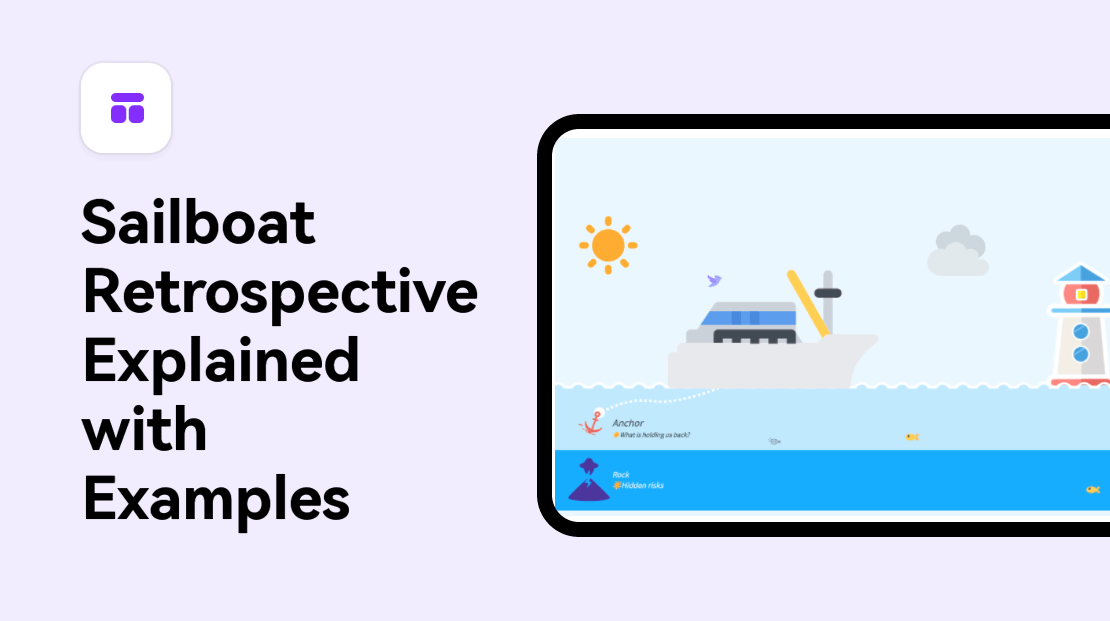
What Is the Sailboat Retrospective
The magic of the sailboat retrospective is that it asks you and your team members to imagine yourselves as the crew of a boat. If you want to reach your final destination (i.e. the sunny island), you must identify the dangers and the risks. At the same time though, you have to also recognize all those things that will help you move closer to your goal.
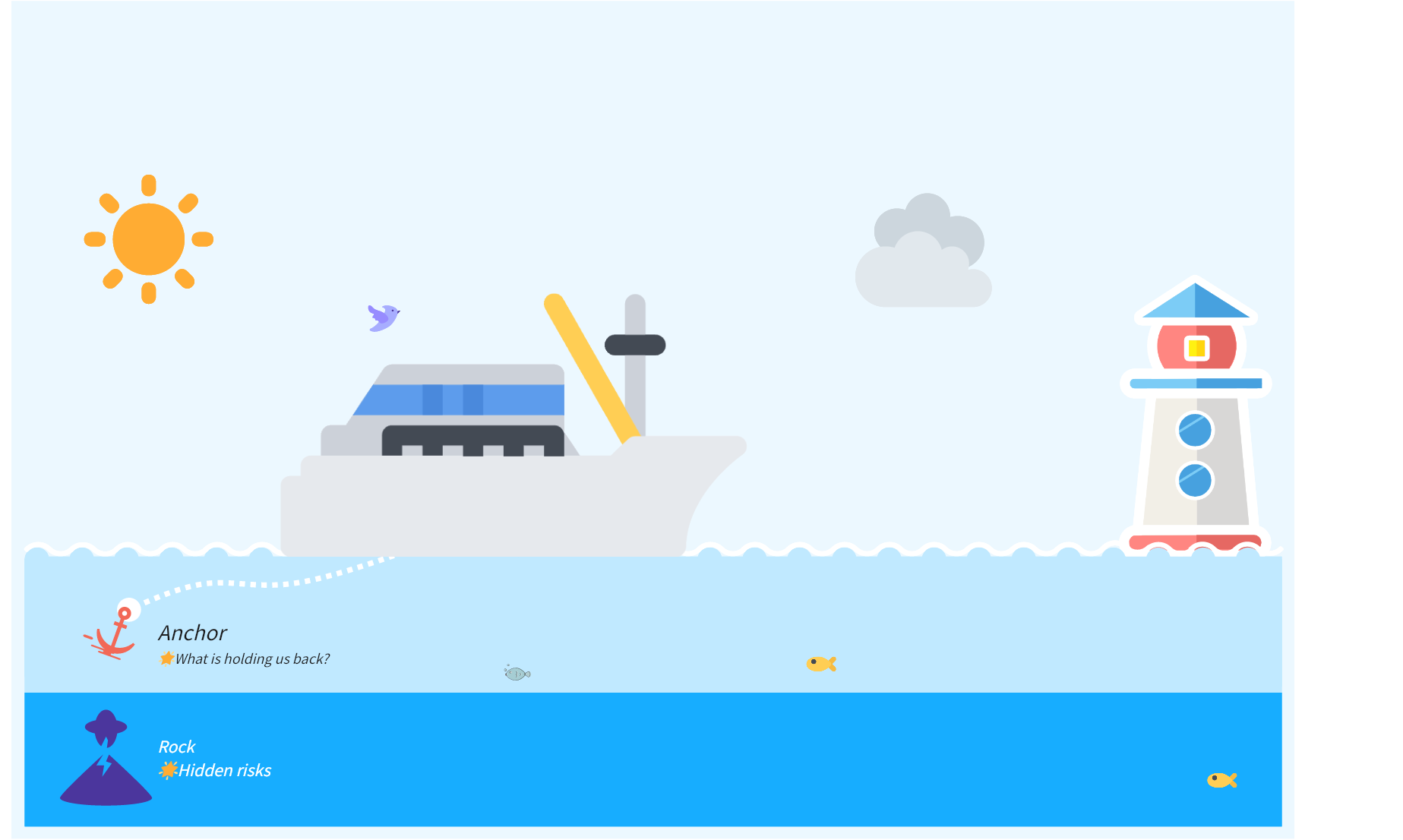
The sailboat retro is an agile retrospective that makes the evaluation process fun by taking advantage of the above metaphor. Therefore, every member of the team can visualize the project’s goal and the route towards achieving it. With a simple sailboat retrospective template, you can immediately get started with this invaluable technique.
What Should a Sailboat Retrospective Include
Before you are in a position to understand and utilize a sailboat retrospective template, you must first learn what each element on the visualization represents. Then, you can study various sailboat retrospective examples to see what is often included in each one of these parameters. In more detail, a sailboat retro should contain all of these elements:
The Sailboat – at the center of any sailboat retrospective there is the sailboat. As you can easily infer, this element represents the team or the team members that are working on that particular sprint. They are the ones that work on that particular project and can give you invaluable insight.

The Lighthouse or the Island – in all sailboat retrospective examples, you will find that everything moves toward the lighthouseor the island. This happens because this element represents the end goal. All the other parameters are just some tools that will allow you to reach the destination as soon as possible.

The Rocks – no sailboat retrospective template is complete without the rocks. This visual element indicates the threats and risks that you will face. In the sailboat retrospective metaphor, this means that if your boat falls into the rocks, then you run the risk of sinking. What’s even more important in this case is that you must also identify hidden risks, that aren’t visible from the beginning.

The Wind or the Sails – another thing that you will find in any sailboat retrospective template is the wind or the sails. With this element, you will be noting all the things that make your project move forward. For instance, this might be a competitive advantage you have gained or particular skills that your team members have obtained.

The Anchors – another element that you will find in a sailboat retro is the anchors. In a boat, an anchor is something that prevents it from moving either forward or backward. Therefore, this element represents everything that puts a stop to your progress. In the sailboat retrospective examples, you will see that the anchors show the bottlenecks during the process.

The Sun – the final element that a sailboat retrospective should include is the sun. Even though this is an optional element, you can add it to highlight what makes your team work. In a sailboat retro, the sun shows what makes the team members happy and what makes their collaboration effective. The positive feedback will give everyone fresh motivation to keep up the good work.

When to Use a Sailboat Retrospective
As you can see, a sailboat retrospective is a useful technique. In fact, you will benefit from using it in various stages of the project. Namely, you can apply a sailboat retrospective template in these instances:
- Upon the completion of the project – one of the main uses of a sailboat retro is to evaluate how the sprint went. This way, you can create one upon the completion of the project to see what worked well and what can be improved in the future.
- In your regular team meetings – a sailboat retrospectiveis also commonly used in regular meetings to show the project’s progress. With this tool, you can identify bottlenecks, risks, and dangers as you move forward. This way, you can eliminate these hurdles before you come across them.
- At the beginning of a new sprint – a sailboat retrospective template will also be very useful at the beginning of a new sprint. You can use the previous sprint to showcase the bottlenecks and challenges that you faced to create a new strategy that will eliminate them.
- When the project faces some challenges – a sailboat retrospectiveis especially helpful when you seem to have hit a wall. If your project isn’t progressing as you had planned, then this technique will allow you to consult with your team members and spot what is causing the issue. This way, you will be able to find solutions that will make your boat move closer to the island.
5 Sailboat Retrospective Examples
Sailboat Retrospective Example – App Development
We begin our sailboat retrospective examples with one that an app development team might find useful. In this example, the team examines all the elements that make their project move forward, as well as all the potential risks.
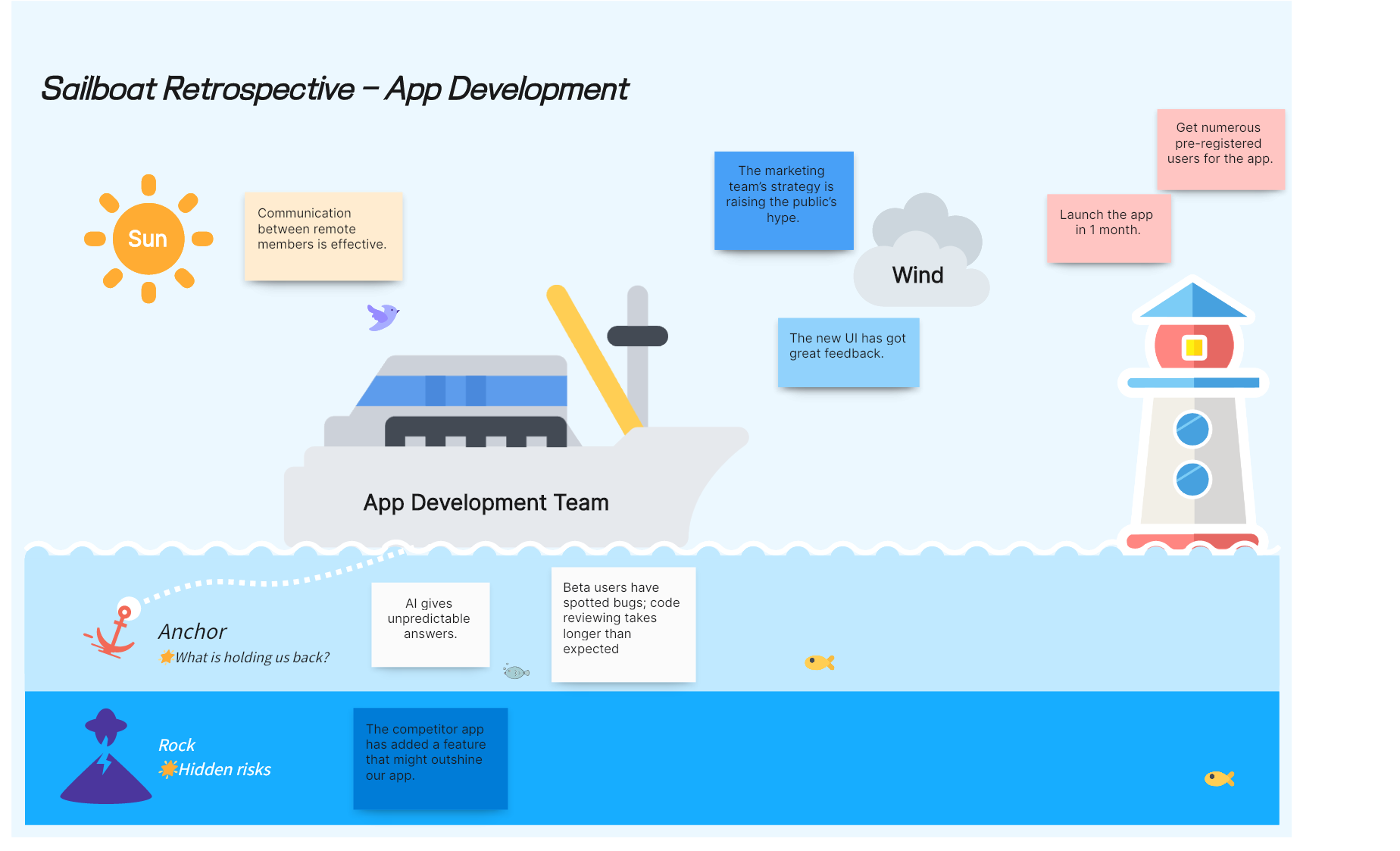
- The Sailboat – the app development team.
- The Lighthouse– launch the app in 1 month; get numerous pre-registered users for the app.
- The Rocks – the competitor app has added a feature that might outshine our app.
- The Wind or the Sails – the marketing team’s strategy is raising the public’s hype;the new UI has got great feedback.
- The Anchors – beta users have spotted bugs; code reviewing takes longer than expected; AI gives unpredictable answers.
- The Sun – communication between remote members is effective.
Sailboat Retrospective Example – Marketing
In the following example, we will take a look at a sailboat retrospective template used by a marketing team. In this case, the team wants to increase the sales of a particular product.
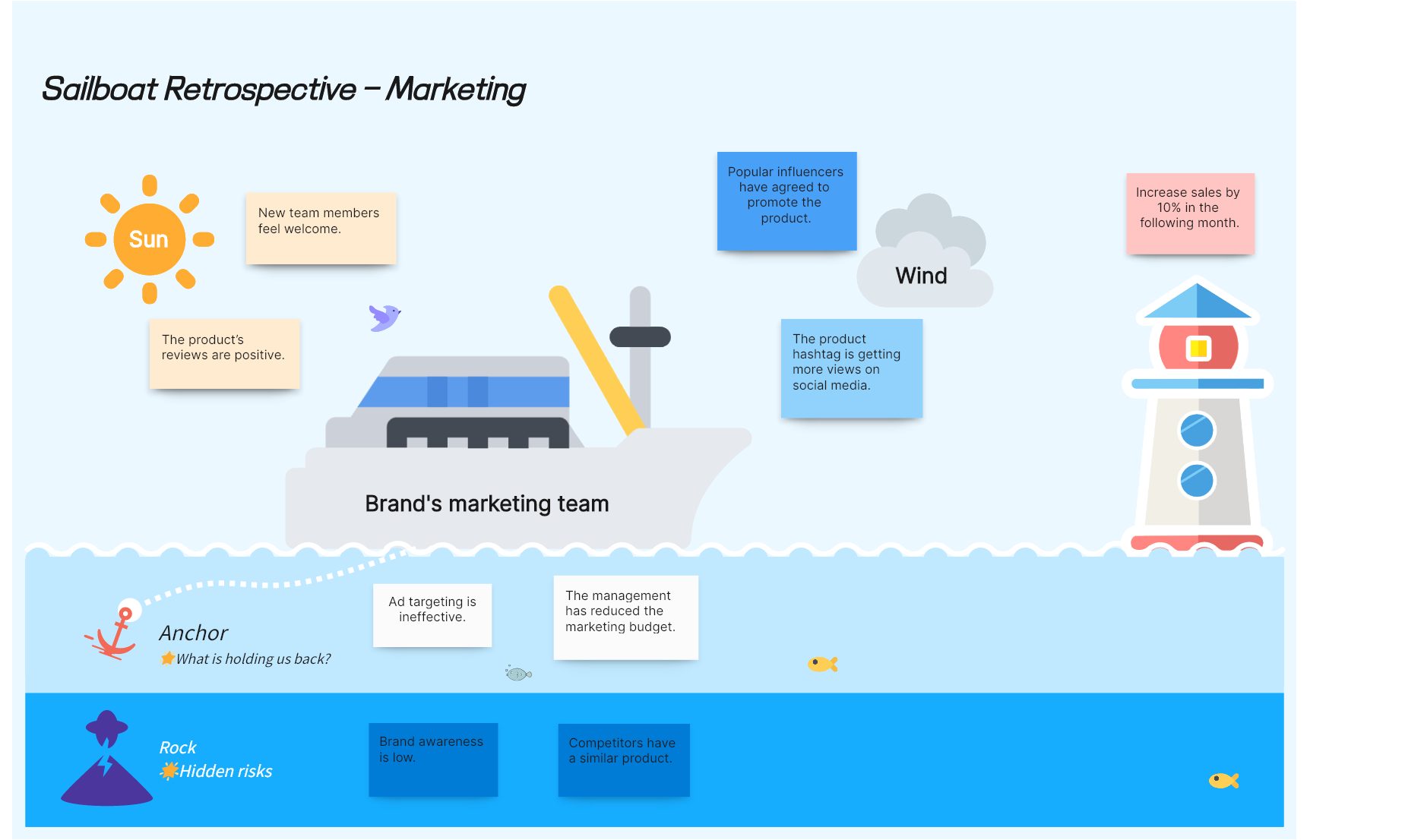
- The Sailboat – the brand’s marketing team.
- The Lighthouse– increase sales by 10% in the following month.
- The Rocks – brand awareness is low; competitors have a similar product.
- The Wind or the Sails – popular influencers have agreed to promote the product; the product hashtag is getting more views on social media.
- The Anchors – ad targeting is ineffective; the management has reduced the marketing budget.
- The Sun – new team members feel welcome; the product’s reviews are positive.
Sailboat Retrospective Example – Online Sales
In the following sailboat retrospective we are going to see, we are taking a look at an example from a retail store that wants to boost its online sales. In essence, this is another sailboat retro that a marketing team might use.
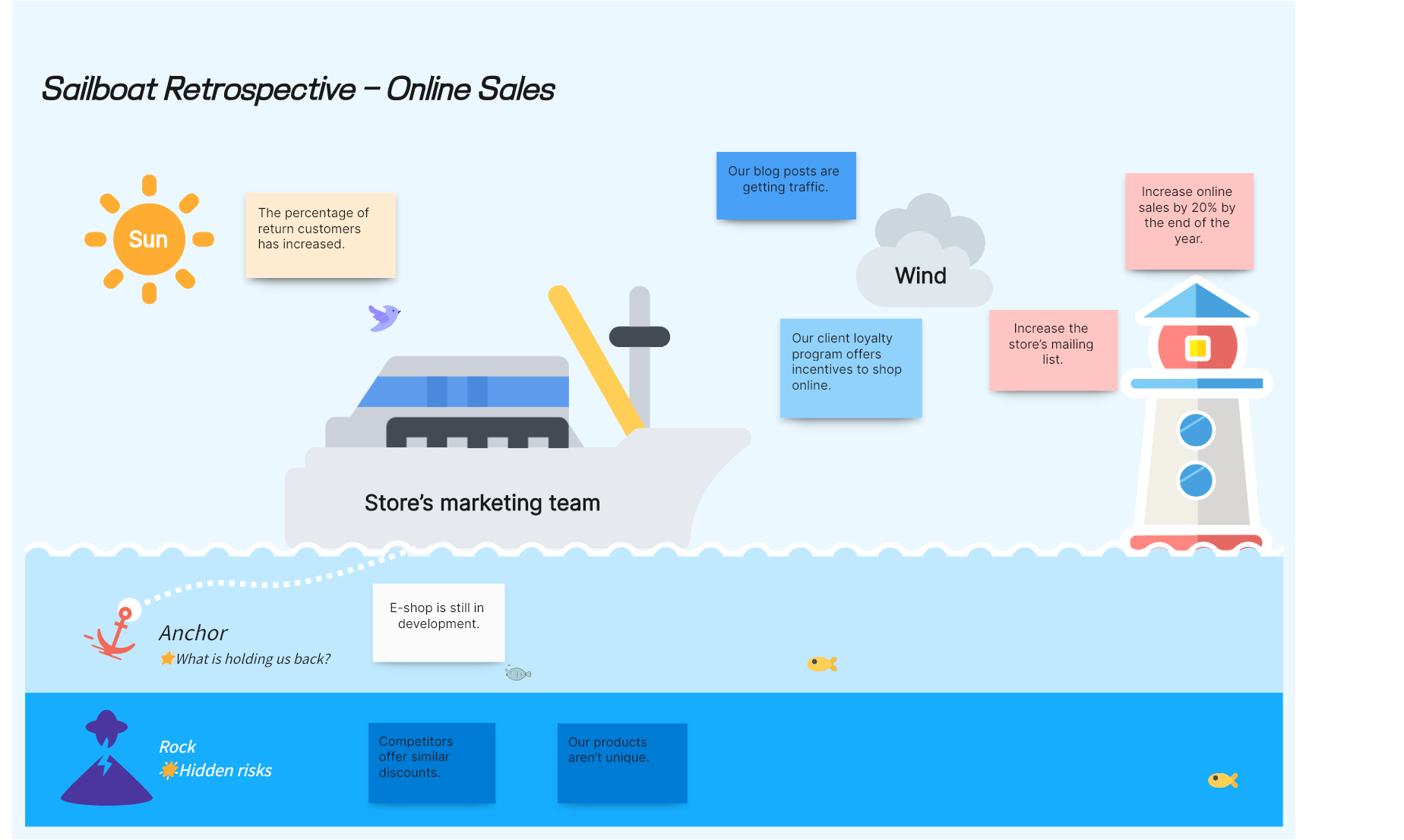
- The Sailboat – the store’s marketing team.
- The Lighthouse– increase online sales by 20% by the end of the year; increase the store’s mailing list.
- The Rocks – competitors offer similar discounts; our products aren’t unique.
- The Wind or the Sails – our blog posts are getting traffic; our client loyalty program offers incentives to shop online.
- The Anchors – e-shop is still in development.
- The Sun – the percentage of return customers has increased.
Sailboat Retrospective Example – Product Design
The next sailboat retrospective example comes from a design team that aims to create new product packaging. In this case, the team members are collaborating to create a design for a physical item.
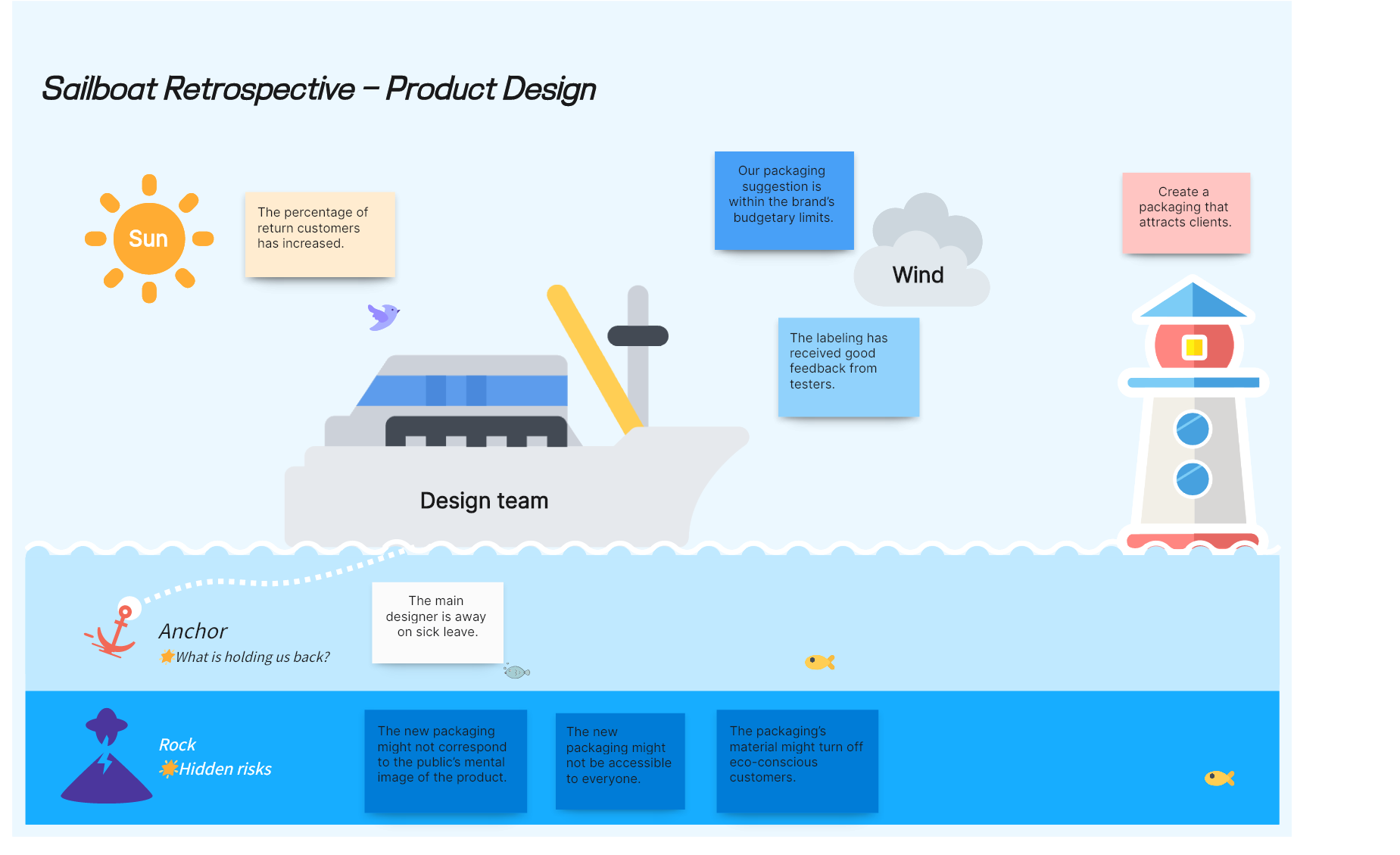
- The Sailboat – the design team.
- The Lighthouse– create a packaging that attracts clients.
- The Rocks – the new packaging might not correspond to the public’s mental image of the product; the new packaging might not be accessible to everyone; the packaging’s material might turn off eco-conscious customers.
- The Wind or the Sails – our packaging suggestion is within the brand’s budgetary limits; the labeling has received good feedback from testers.
- The Anchors – the main designer is away on sick leave.
Sailboat Retrospective Example – UX Design
The last sailboat retrospective example is that of the UX design of a new website. In this instance, the design team needs to collaborate with the development team to create a user-friendly online application.

- The Sailboat – the design team; the development team.
- The Lighthouse– create a website where users can complete the task within 1 minute.
- The Rocks – the task requires many steps; the usability of the website needs improvement.
- The Wind or the Sails – usability testing is taking place without delays; a great percentage of test users complete the task within the time limit.
- The Anchors – beta testers have given conflicting feedback; the teams have difficulty finding enough time for meetings.
- The Sun – remote communication between teams is effective.
A Ready-made Sailboat Retrospective Template
As you have seen in the above sailboat retrospective examples, this is a versatile technique that can be applied to many different projects. Therefore, adopting the sailboat retrospective agile technique will significantly help you make your sprints progress smoother than ever before.
The truth is that you can create a sailboat retro graph as simple or as complicated as you would like. However, with a ready-made sailboat retrospective template, you will have a well-designed and professional base that you can use in your meetings. In Boardmix, you will find a sailboat retrospective template with which you can immediately get started.
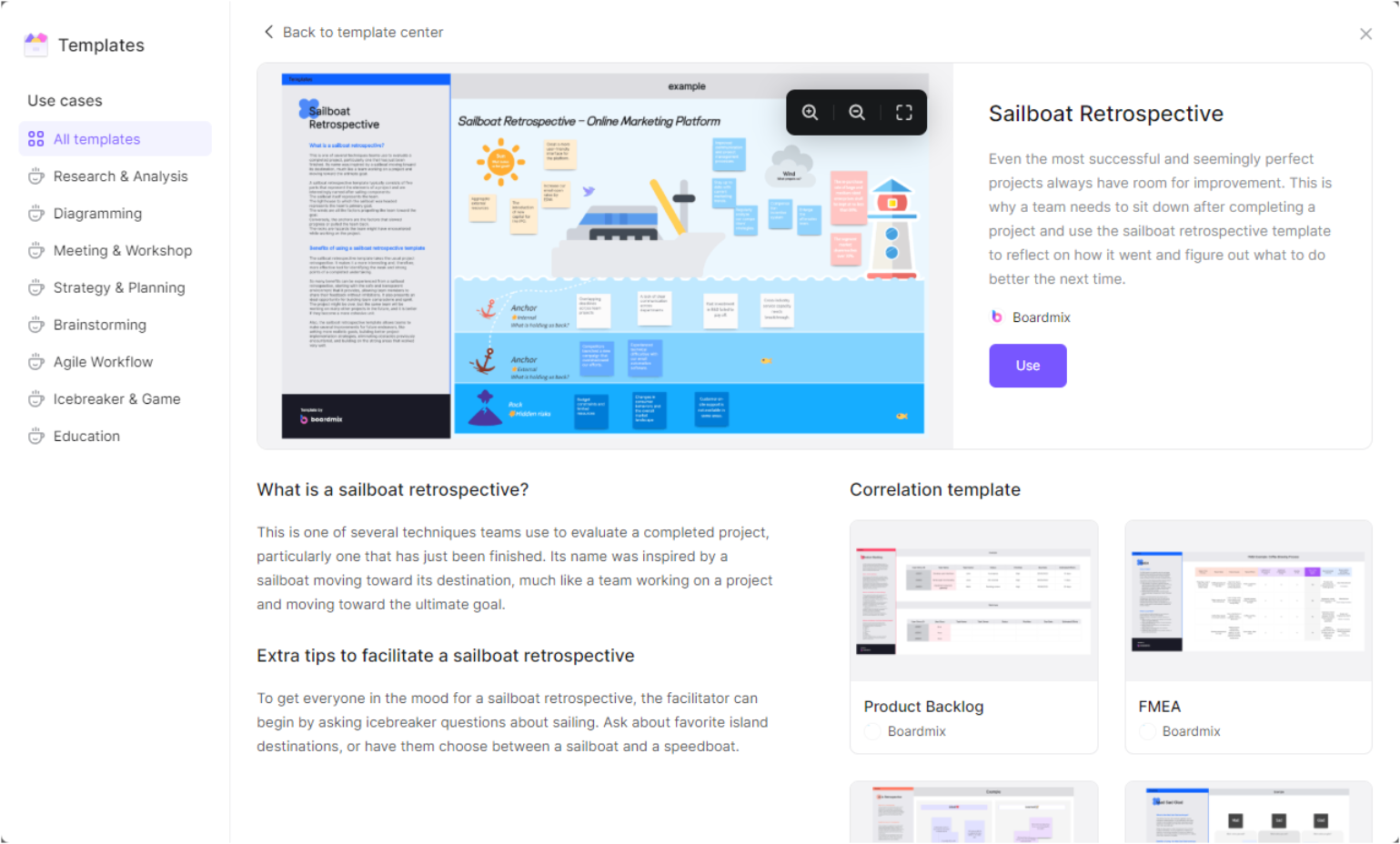
How to Run a Sailboat Retrospective with Template
Once you create your Boardmix account, you will gain access to many features that boost the collaboration between your team members, even if they are working remotely. Therefore, running a sailboat retrospective with this online tool can become an easy process. Here is what you need to do:
Step 1 – Go to your Boardmix workspace and click the Templates button. There, you will find the ready-made template for a sailboat retro.

Step 2 – Share the graph you have created with your team members.

Step 3 – Once they have all accessed the sailboat retrospective, Boardmix allows you to have an online meeting. Namely, you can have a video meeting or enable the chat.

Step 4 – Then, each member can contribute to the sailboat retro. Every member can add sticky notes with their thoughts and every participant will see the changes in real time.
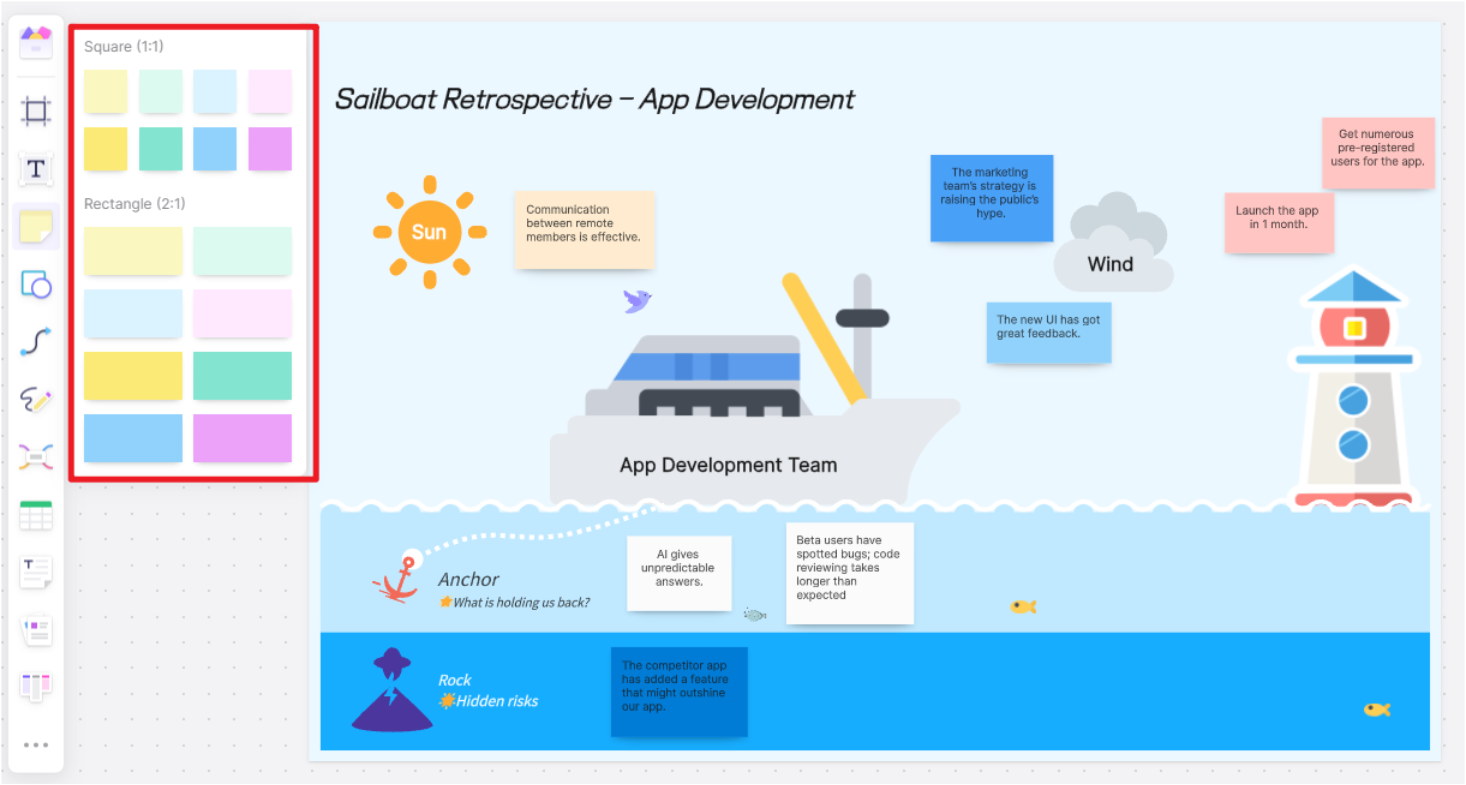
Step 5 – Finally, once the sailboat retrospective is complete, you can save it in various file formats or create an immersive presentation. This will help you present the graph to the management or stakeholders in a professional way. If you want to complete everything online, you can share it simply via a link.
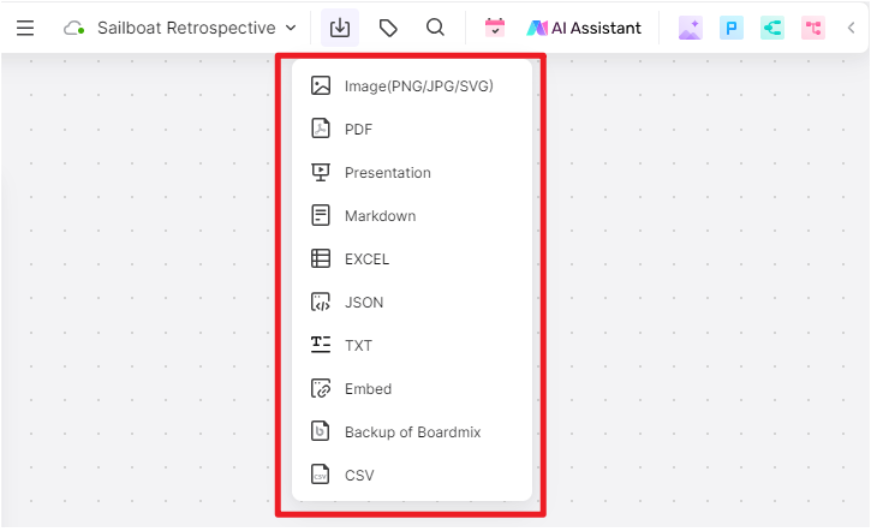
Extra Tips to Boost Your Sailboat Retrospective
As you may have already understood, a sailboat retro is a technique based on good communication. Therefore, it is important to make your team members feel comfortable to share their opinions on the sprint’s progress. Some tips that will help you are the following:
- Set some communication rules before the meeting. This way, every team member will know that their opinion will be heard and valued.
- Study sailboat retrospective examples beforehand. By doing this, you can determine which questions you must ask to uncover all underlying issues with your project.
- Keep the meeting fun and light. A sailboat retrospective usually takes place after the project’s completion. This means that there is no pressure, and you should create a pleasant environment.
- Set time limits. During the meeting, you should use timers so that each team member has the chance to state their opinion.
Wrapping Up
The sailboat retrospective is an invaluable agile technique. Start using it after each sprint to identify what works and what doesn’t to make your projects move faster and more efficiently than ever before. In Boardmix, you will find a sailboat retrospective template to take advantage of its many benefits immediately. Just try it out now!








